Nightwing (1979)
Directed by: Arthur Hiller, George McCowan
Written by: Bud Shrake, Herbert Wright, Lynette Cahill, Martin Cruz Smith, Norman Thaddeus Vane, Peter Jensen, Steve Shagan
Starring: Chief Dan George, David Warner, Jan-Michael Vincent, Kathryn Harrold, Marilyn Hassett, Nick Mancuso

It’s a busy review week for the Doc, so he’s not going to spend time searching for background information of most of the films he’s writing up, nor post every review of each film separately so he totally dominates the review section of the site for a few days. First up is this two-fer from Eureka Entertainment, a sort of ‘Special Edition’ of a Region ‘A’ release from Mill Creek.
USA
AVAILABLE ON BLU-RAY: 15TH MARCH, from EUREKA ENTERTAINMENT
RUNNING TIME: 105 mins
REVIEWED BY: Dr Lenera
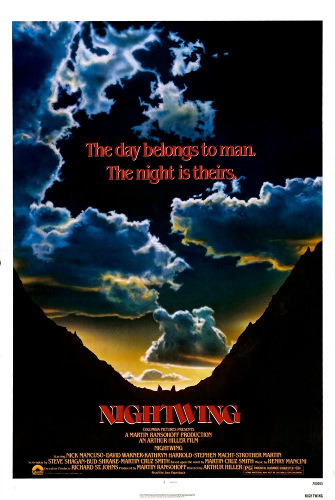
Youngman Duran is the Police Deputy on the Maskai tribe’s reservation in Mew Mexico. He’s at odds with Tribal Council chairman Walker Chee who is modernising the life of the Maskai, and who’s just heard that oil has been discovered in the nearby sacred caves of Maskai Canyon. He goes to visit medicine man Abner Tasupi who brought him up, and finds that, fed up with the white man’s environmental meddling, he’s cast a spell to end the world. And then there’s these mysterious animal mutilations which British scientist Phillip Payne believes that they’re the work of vampire bats….
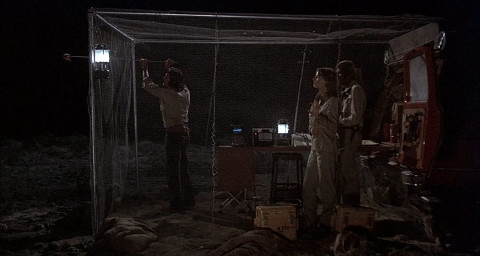 .
.
Surprisingly similar to the same year’s Prophecy and perhaps a tad better if not quite as fun and not packing in as much, Nightwing seems to have a rather poor reputation, but I found it really interesting it not entirely successful. Perhaps the melding of monster movie, racial commentary and mysticism doesn’t quite succeed in totally balancing its elements or developing them as much as it could have done. It may disappoint those just after lots of animal action, because there isn’t very much of that, though the special effects are often better than you may have read, especially if one takes into consideration the fact that bats are almost always hard to present practically in a convincing manner. And there’s one enormously tense set piece where director Arthur Hiller seems totally focused and doing his best to heighten the proceedings, though otherwise he doesn’t seem particularly interested in the horror aspects, even though this was apparently a project he chose to do over a sequel to his hit Love Story, so it wasn’t a paycheck job for him. But it’s surprisingly ambitious, balanced in terms of the issues it presents, and even just a bit ambiguous in terms of what is really going on and why. And, despite two of its lead characters being Native American but being played by Americans, one of whom doesn’t even look Native American [unlike many others I’m not much bothered by people of one race playing people of another, but at least there should be an attempt to look like the race that’s being portrayed], the script is quite respectful of Native American matters without sentimentalising them.
We are initially treated to shots of the desert at various times which gives us a great sense of the environment in which the action will take place, and tells us that the land will be a major part of the story – in fact it’s central and probably even more important than the bats. Heard over this is some music by Henry Mancini that’s enormously evocative of the setting with its approximation of Native American sonics without getting all cliched. It’s easy to forget that Mancini, despite being best known for his immortal and often divinely beautiful tunes for the likes of The Pink Panther, Charade and Breakfast At Tiffany’s, also wrote a lot of darker, less melodic, more experimental stuff. We see somebody standing atop a huge rock with their arms stretched out, before we cut to where some horses have been found bitten with lots of blood drained out and the strong smell of ammonia around them. Our hero Youngman is upset to see Walker, a chief from the neighbouring Pahana tribe, arrive by helicopter with a veterinarian, since the Pahana don’t have jurisdiction in the area. Considering his own tribe’s impoverishment, Youngman resents the Pahana’s affluence, as well as Chee’s business schemes even though they’re well intentioned; there’s certainly an argument for bringing industry to the Native Americans. Youngman then visits Abner, a Maskai priest who’s been banished from the community for witchcraft. Abner declares that he’s cast a spell to end the world in a painting he’s done. He wants to kill off all the white men because of their planet-threatening greed, and is okay about killing off his own kind too, ends justifying means. He predicts that he’ll die that evening, which he does while Youngman is spending time with his nurse girlfriend Anne who’s about to go off to college. These scenes are weakly written and performed so we don’t care much about this couple and just want to get this over with, except for one telling detail involving both race and class; he’s jealous that she’ll get lots of attention from white students.
Soon we get an attack on a shepherd and some sheep which isn’t badly done and actually benefits from the bats not being shown, though eventually we do get some travelers getting it, and, even if the special effects are a mixed bag, the intensity rivals some of the scenes in The Birds. One of the members of this group is Anne, and of course she survives, but Youngman has to find her out in the middle of the desert. There’s not really enough urgency when there should be, but luckily David Warner, usually playing villains around this time [which meant for a while I expected him to be behind the bat attacks in some capacity], is on hand to liven things up when the other listless leads don’t seem to be trying very hard. He has a knack of making average or even poor dialogue sound good, and here his character Philip is given speeches [he kills bats because ”they’re evil”] which may have seemed stupid in the hands of many other actors. And yes – his claim that Jesus created vampire bats can be stretched to being true – the Koran says that he did create bats, if not necessarily vampire ones. Philip examines a blood specimen and works out that the bats carry bubonic plague [cue talk of “quarantine” and a “vaccine”] which will offer some resistance to the plague. He also explains that the ammonia smell results from the bats discharging excess blood in order to become airborne again. The colony will eventually be drawn to human populations and spread the plague, but Philip thinks he can track down the bats in time, with Youngman and Anne along for the ride – and even though unwelcome, Anne soon proves herself to be certainly not the kind who screams and needs to be rescued. It seems that a human villain is after Youngblood for reasons I don’t really need to go into, but the film’s most exciting scene is when our trio are sheltering in a electrified cage as thousands of bats close in and the battery that’s supposed to electrify doesn’t work.
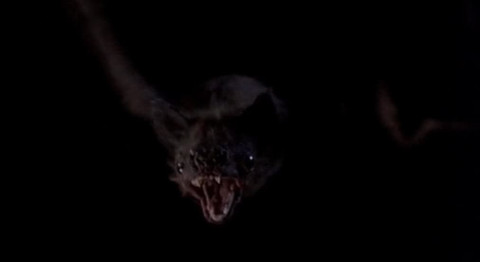
The climax includes the consuming of the root of a [real] plant called ‘datura’, which is depicted as one of those magical movie drugs that takes effect immediately, though Hiller’s not one to give us some trippy visuals. We are, though, invited to think about what we are seeing, and even wonder about the ending, where maybe it’s certainly not all about the bats and there’s some dark irony afoot, and not just because these bats live in a sacred place. Said animals are realised through a combination of real bat footage for the scenes of the masses of bats on the walls of their cave, optical animation for when we see lots of them they’re flying around, and animatronic marionettes created by Carlo Rambaldi for the close-ups. The animation doesn’t work particularly well though I’ve seen worse from the period. As for the marionettes, they’re quite detailed and quite accurately designed too, so much so that they almost convince as creatures; unfortunately though they don’t convince as bats, largely because of the slow, almost graceful way that they fly. Real bats are quick and blurry when they fly, and for some reason are rarely depicted like this in films. Still, Rambaldi’s work, though much criticised, is several steps above those laughable things in the Hammer films – which leads me to mention the baffling fact that this film won Worst Picture and five other awards at the 1979 Stinkers Bad Movie Awards [no, me neither], including ‘Worst Non-Human for The Killer Bats’ which seems incredibly harsh. As with the much better known Razzies, the folk who voted evidently hadn’t seen many films. I would have thought that, for example, they would at least have seen that screenwriters Martin Cruz Smith, Steve Shagan and Bud Shrake, adapting Smith’s novel of the same title, were attempting to create something something deeper than the average creature feature.
Of course there’s the flip side to the above. While we get some blood oozing out of a sackcloth, Nightwing no doubt doesn’t deliver much of what it promises in terms of horror thrills, even though I reckon it’s still easy to appreciate things like Mancini’s atmospheric work where the musicians in the string section were told to un-tune their instruments so they sounded ‘off’. There’s no doubt that what we’re really talking about here is the white man’s destruction of the environment, and the sad existence of Native Americans who were forced into these reservations while the white men took the rest of the land. Yet things never become preachy, and we’re reminded that industrial progress is in many ways a very good thing despite how bad it often is for the land. There’s an interesting character named Selwyn, well played by Strother Martin. He’s a white shopkeeper who’s married a Native American and wants Youngman to marry one of his daughters. He’s either still a bigot, or he winds customers up with tales of these awful Indians who go so far as to chop up an old lady – and some of the customers seem to believe this. His role is either to show that it’s hard to rid yourself of your racist views, or to show hope that the two cultures can properly get along while mocking stereotypes. You’re asked to decide. And indeed the main gist of Nightwing is hopeful. While it doesn’t ram this down our throats like a modern film might do, it seems to suggest that the spirituality of indigenous people could slow down or even halt the ecological danger wrought by us ‘civilised’ folk. It’s a thought which might be even more pertinent today, and which is very close to my heart and confirms my thoughts I had earlier on in the course of writing this review; that Nightwing may be average in some of its more obvious aspects, but that it has quite a bit more going on.
Rating: 









Eureka have probably ported over the Mill Creek version and given it a new encode. Every now and again we get a shot which is slightly softer than the rest of the film, it’s certainly not distracting though and may not be noticeable if you’re not looking out for such things. Likewise some tiny white specks indicating print damage. There’s solid detail and good depth and texture.
SPECIAL FEATURES
English SDH subtitles
Brand new audio commentary by film historians Lee Gambin and Amanda Reyes
I’d heard Gambin several times before, and recently listened to Reyes on the Pulse audio commentary, so I was looking forward to this track. The two have good interplay as they delve deeply into the issues of a film they both really admire without ever getting too dry. There obviously isn’t too much background information on Nightwing, but we learn that Rambaldi presented his bats to the producers and was told “you’ve made our bats too big”, that Smith didn’t like how Nightwing turned out and made T-shirts saying READ THE BOOK, DON’T SEE THE FILM, and of an alternate ending which would have allowed us to see human evil getting its just deserts. Of course there’s a lot of linking with similar films, but that was fine with me; I’ve always been a bit interested in the ‘Indiansploitation’ genre and may now have been spurred on to to explore it further. And then there’s the strange fact that horror fans often like to praise horror directors for including things like social commentary in their films but don’t seem keen on non-horror filmmakers trying their hand at the genre and bringing in other themes. At the end of the track, the two hope that they’ll reunite for further ones. I do too.
Oil and the [Geo]Politics of Blood – Audio essay by John Edgar Browning [37 mins]
Heard over the first third of the film, this has Browning read out an essay he wrote in 2013 about Nightwing and its themes, though it begins by briefly discussing Pale Rider which to him also had eco-gothic elements; I’d never thought of that before but I guess he’s right. Though very scholarly, Browning never loses the listener as he points out things like the correlation between the blood sucking bats and modern industry which “drains mother earth of its vitality”, and the use of concerns like its attitude to scripted history and the mystery of the frontier.
Trailer
USA
AVAILABLE ON BLU-RAY: NOW, from EUREKA ENTERTAINMENT
RUNNING TIME: 92 mins
REVIEWED BY: Dr Lenera

Life is going fine for half-Native American business executive Mike until he begins to have glimpses of a scary demonic figure. Then his grandfather Old Man Hawk, a medicine man, arrives in Vancouver to seek his help in battling an evil witch named the Dsonoqua who’s returned from the grave. Mike has little interest in such things, but along with journalist Maureen is drawn into this struggle when he starts to drive Hawk home….
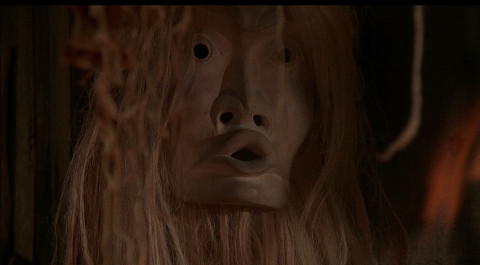
Not having read any synopsis of this one, I assumed that it would be another killer animal flick, this time involving hawks. Well, there are some encounters with deadly fauna, but it’s more of a lower budgeted Native American-centred variation on The Devil Rides Out. The premise of the whitebread Native American rediscovering his heritage is usually an interesting one, and there are some highly effective and even eerie scenes. It begins in quite scary vein, so much so that I was getting a bit on edge, but this feel lessens as the movie goes on and becomes more of a supernaturally tinged adventure story, though not really a bad one as long as you don’t expect ot to make much sense. It keeps on throwing incident at the viewer, so much so that I think even today’s younger teenagers will find it exciting, but suffers from having a hugely sudden ending which looks as if the makers had ran out of money, along with some ridiculous stuff and confusion; for example I couldn’t work out all of the details of its villainess. George McCowan, probably best known for Frogs and The Shape Of Things To Come [a Star Wars cash-in that’s almost as daft as Starcrash], directs pretty well except for his cast seem a bit disinterested with one exception. Chief Dan George, who’d been such a wonderful part of Little Big Man and The Outlaw Josey Wales, and who – would you believe it – made his first screen appearance at age 65, is as great as always even though he looks rather weak. Lacking the deeper themes of the other film, Shadow Of The Hawk certainly has its intriguing aspects and moves at a cracking pace in contrast with the surprisingly sedate Nightwing.
A confusing opening scene has a pan across a lake reveal a funeral on the shore while elsewhere there’s some kind of ceremony to heal [I think] a sick girl, plus some similar though livelier shenanigans somewhere else involving chanting, snake charming, pipe smoking, women getting it on while throbbing weirdly in what seems to be a trance rather than sex, and the Dsonoqua herself, though it took me a while to realise that we were seeing her in the flesh rather than as the mask-wearing entity we not just elsewhere but hanging up on a wall here – the cutting creates confusion. We learn that, two hundred years ago, the Dsonoqua murdered her husband and kids [and maybe even ate them too as Hawk calls her a “cannibal”] and was in turn killed by Hawk’s ancestors, but came back as a ghost. It looks as if she’s in this hut where we see all this shamanic stuff going on, but why is she even allowed to be in this place? Maybe a long list of ceremonies have failed to get rid of her, but we should have been told this, otherwise it just seems ridiculous that a ghost [though admittedly she doesn’t look like one] has lived in this village for so long openly. It does fees like the writers of this movie – Norman Thaddeus Vane and Herbert Wright from a story by Vane, Peter Jensen and Lynette Cahill – just couldn’t be bothered to think everything through. Still, the early appearances of the demon that’s summoned by the Dsonaqua to Mark in a swimming pool and outside his bedroom window [the latter almost as creepy as Salem’s Lot‘s famous nocturnal visitor] carry a real charge of terror as strong as anything in the Insidious or The Conjuring flicks despite CGI not being available; we see very little of the body, us having to focus on that very unsettling mask. But the demon eventually takes a backseat and doesn’t even show up for the climax!
Hawk is bothered by the increasing power of the Dsonoqua and sets off for Vancouver. Are we really intended to get the impression that he actually walks all the way, especially as he doesn’t seem like the hitchhiking type at his great age? And the Dsonaqua decide to wait until he’s got there before she carries out some voodoo which results in Hawk collapsing on the street. He’s taken to hospital where journalist Maureen senses a story. There’s a nice little moment where Hawk sees her for the first time, looking up from his gurney while she wipes his brow. It’s as if the two are already linked. This is what I mean about this film; for every weak bit there’s something that’s good or at least interesting. Hawk walks out of the place really easily despite his age, and gets Maureen to help him find his grandson. He’s holding a swanky party and has a girlfriend called Faye, though she’s totally forgotten about a few minutes after. We know that Hawk and Mauren are instantly attracted to each other, this film being made at a time when they would just have to sleep together and early on too, it wouldn’t be right if they didn’t. Why was Faye even in the script? It makes Mike seem just a bit less sympathetic because he’s cheating on her. Mike, who hasn’t been to his home village in many years, doesn’t want to hear about his grandfather’s nonsense and even gets Maureen to dump him at the bus station even though it’s very late. But he reconsiders and then notices that Hawk sees a black car parked just outside the restaurant that they’re eating in. He looks at the driver, a moment heightened by close zooms, who then drives off. Despite this strange occurrence, Hawk offers to take him home himself, with Maureen along for the ride. However, dark forces don’t want them to reach their destination, the rest of the film being the three trying to reach their destination amidst a variety of hindrances..
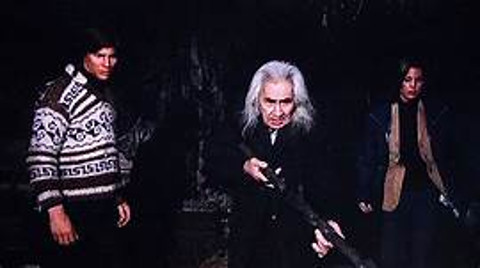
That darn black car appears and disappears at will, sometimes in front of them. There are human opponents that are sometimes slightly superpowered, animals, and even a dangerous rope and wood bridge that seems to collapse under our trio’s very feet in a genuinely hair-raising sequence where it looks like the cast members were really there for much of the time [I noticed no rear projection]. It’s so good that we can forgive the fact one stunt person has the wrong colour hair. There’s also a really impressive moment where a car crashes into an invisible wall; edits are used to put the scene together but it still looks darn good and beats any CGI. Real creatures are used apart from some quick shots of a bear suit, with quick editing sometimes used to disguise the fact that the bear and wolf Hawk is fighting are actually really passive – though not as passive as Jean-Michael Vincent who starts off pretty well but then lapses into being as wooden as ever. He rarely seems to try, preferring to think that he has Steve McQueen-like charisma so can get away with doing very little emoting. He doesn’t and can’t, instead just looking bored even though his character undergoes more than one journey. He’s learning how to be a warrior and even takes some [unnamed] hallucinogenic plant like Youngman in Nightwing, a scene that has a little bit more done with it than the comparable one in the other film, with some blurring of the image. By the time some shiny white-faced zombies show up it seems that things are attaining new heights of looniness, but then things suddenly finish up, with the film’s main menace being defeated extremely easily. We’re even given more than hints that one character is going to die, which may have given things some gravitas, but it doesn’t happen. Was the final act heavily rewritten?
It’s left to Chief George to provide some genuine human interest. His characters tend to have a world-weary but wry and down to earth philosophy of life, as if George himself had considerable input into the screenplays, and it’s present here if low key. The 77-year old actor doesn’t look well, but still has that twinkle in his eye and his tremendous presence. Judging by the weakness of Vincent and Marilyn Hassett, it looks like first or second takes were used, and McGowan doesn’t generally seem to have given his actors much direction though he does keep things moving. The dialogue can be a bit groanworthy. “I’d like to spend some with you, off the record”, spoken right in front of grandad, must be one of the lamest movie come-ons I’ve heard in a while. An exchange concerning Dsonaqua consists of, “What is it?” “She is close.” “Where?” “Everywhere.” But the outdoor cinematography by John Holbrook and Reginald H. Morris is often really strong, something McGowan aids with some interesting choices of angles here and there which maintain tension. Robert McMullin’s music score is very frequent and relies on much basic description. Sometimes we cut to a hawk, and we hear a triumphant mini fanfare on the soundtrack. Oh yes, the hawk. I’d almost forgotten. It turns up every now and again as a symbol of good, a friendly animal spirit, and occasionally affects the proceedings, proving that the film’s title does refer to the actual film – though it wouldn’t be a big deal if it didn’t. Shadow Of The Hawk is often rather dumb, but it’s never dull and I got much entertainment out of it anyway in spite of its issues – or should that be because of its issues?
Rating: 









A generally brighter looking film than Nightwing, Shadow Of The Hawk exhibits similar very minor instances of damage but lacks the other film’s occasional shots that are softer than the rest of the film, making for a more consistent watch. As a while the picture is slightly less sharp, but you could say that this makes the act of watching this 1976 film seem more authentic. Colours can be quite dynamic and grain is very evenly managed. Pretty good overall.
SPECIAL FEATURES
English SDH subtitles
Brand new audio commentary with film writer Mike McPadden and Ben Reiser
This track makes a nice contrast with the previous one. Again it has two writers who admire the film, and there’s some mentioning of similar and linked films, but McPadden [who co-hosts a podcast called ’70’s Movies We Saw In The ’70s’] and Reiser are lese scholarly in approach, which is no doubt right for this particular movie. The chemistry doesn’t seem to flow at first, with some slightly curt exchanges, but the two still won me over very quickly with their appreciation of the wonderful but little-known-today Little Big Man, and the two get into it their banter and appreciation grows considerably so that, in the end, I probably enjoyed this track more. We learn that this was the third highest grossing Canadian film for some time, that the bear was the one used in the series Gentle Ben, and even some mention of Nightwing. Interesting to hear what was out at the same time as well, even if by then they may have been running out of things to say. A good listen overall.
Trailer
‘NIGHTWING/SHADOW OF THE HAWK’ SPECIAL FEATURES
O Card slipcase featuring new artwork by Darren Wheeling
A limited edition collector’s booklet featuring essays by film historian Lee Gambin and film scholar and author Craig Ian Mann [2000 copies]
These two Native American-themed fantasies may not be totally successful but are pretty interesting. Recommended.



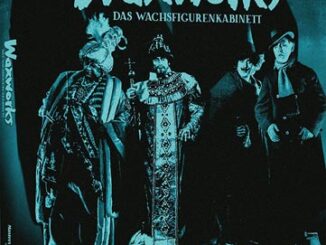
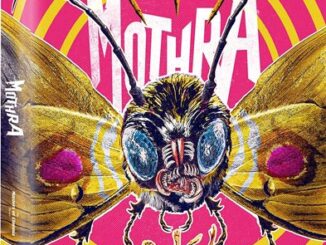
Be the first to comment